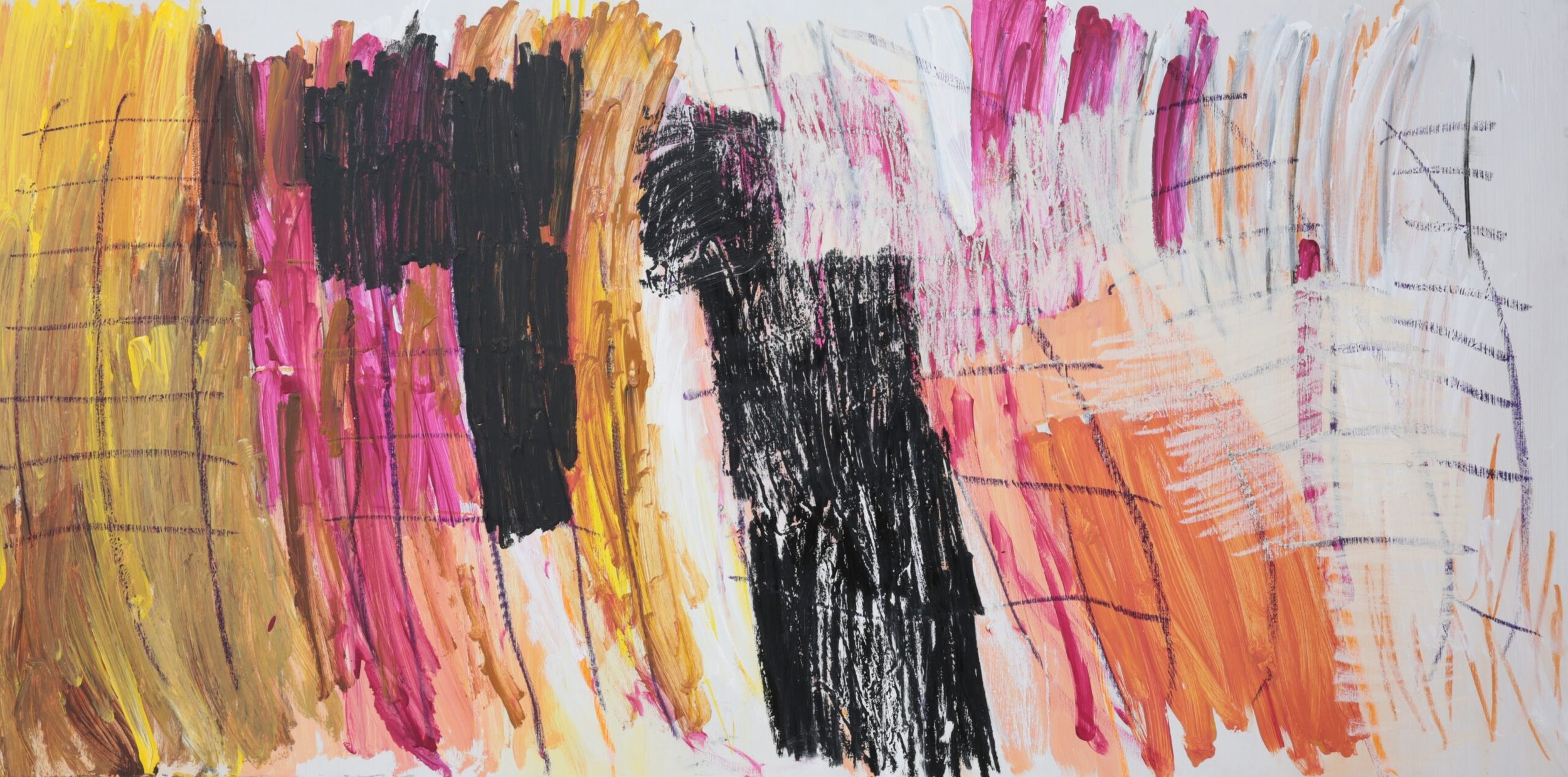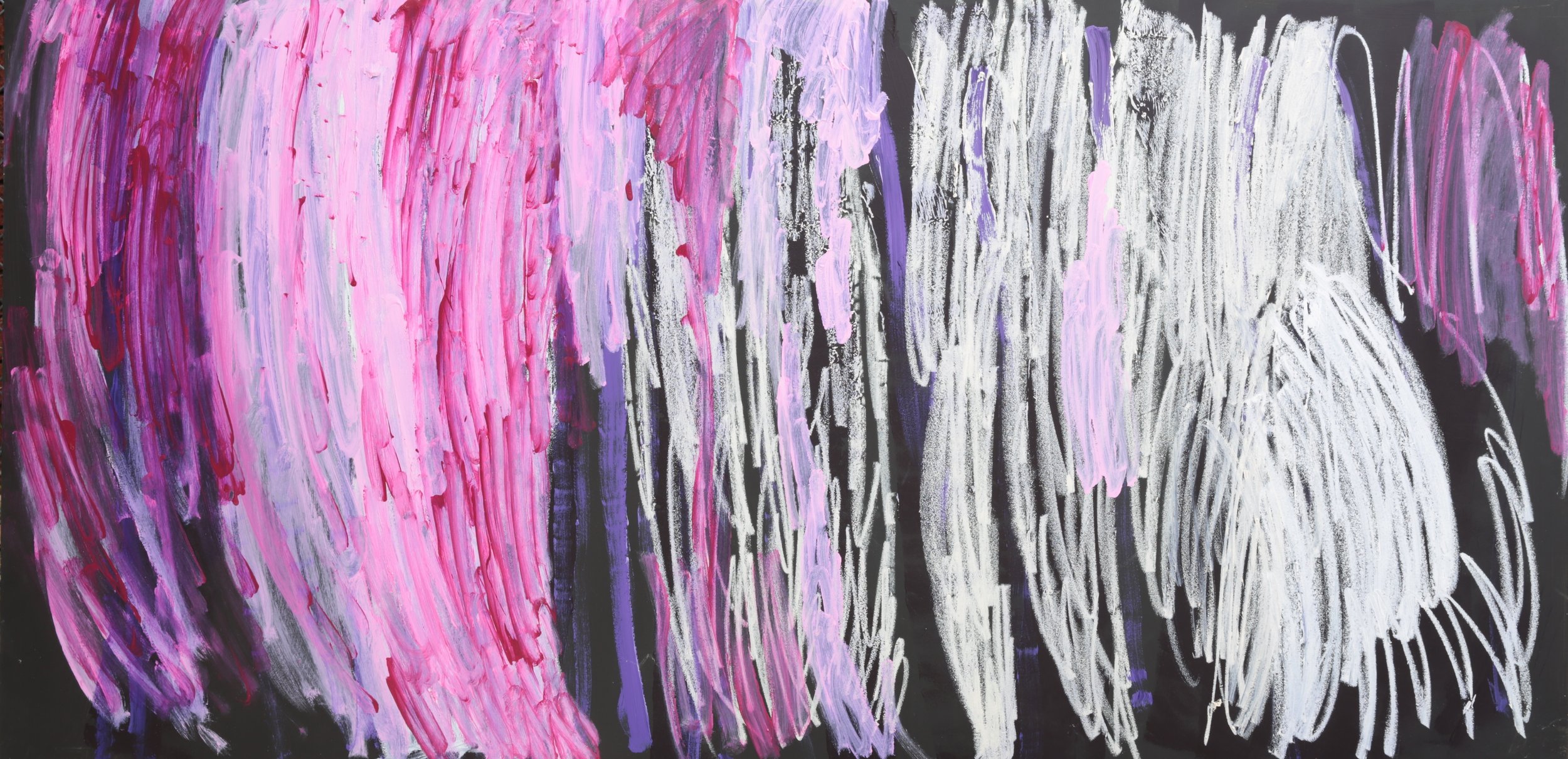lines, grids and triangles: Debut Solo
I wrote a catalogue essay for Katina Anapaikos’s show titled Debut Solo, exhibited at SEVENTH Gallery from 6 April 2022 to 29 April 2022.
Katina Anapaikos is a prolific and longstanding member of Art Day South, a multi-arts studio run by Arts Access Victoria. For over two decades, Katina has developed her unique and intuitive style, often repeating signature gestures across multiple works. Her work is very expressive, communicating a sense of movement and rhythm through her use of lines and colour. Katina uses highly expressive mark making, often incorporating sweeping gestural line, interspersed with fast flurries of colour. Katina’s debut solo exhibition includes a number of large-scale compositions characteristic of her intuitive, gestural mark-making.
Supported by Arts Access Victoria

The process of writing a catalogue essay for an artists’ exhibition is quite linear from start to finish. We first make initial contact, agree on an angle of what to write about – unless I’m given full creative direction – and submit multiple drafts to the artist until all errors are fixed and both the artist and the writer agree that the essay is sufficient for public consumption.
My journey for writing this essay for Katina Anapaikos, however, is quite unique. Katina is a non-verbal artist. To learn more about Katina and her practice, I have spoken with Arts Access Victoria staff who oversee the production of her impressive body of work to write about her first solo show, Debut Solo. As a writer and curator with lived experience of disability, being offered the chance to write about the practice of another Disabled artist is something special.
Katina has been a practicing artist for over twenty years, being one of the longest members of Arts Access Victoria’s Art Day South Studio, which has been operating in Naarm/Melbourne’s south-eastern suburbs since 1991. Katina and other Art Day South artists are encouraged to develop their own studio practices, and sometimes collaborate to create public work in sound, performance, painting, and sculpture within a close-knit community of other Disabled artists. Katina has been exhibiting in both performances and group shows with Art Day South since the mid 1990s, taking part in installations, performances, painting and sculpture exhibitions, and Zoom-based video artworks. Katina started out taking part in the studio’s collaborative performance and art projects. Collaboration was encouraged between studio artists as a primary method of art making. From 2017 to 2020, Katina was a key member of the Art Day South band. Debut Solo is the second solo show by an Art Day South artist.
Around six years ago Katina started to create her own body of work to focus on her own individual arts practice, where she started creating large-scale mixed-media works. Katina has a passion for creating electrically charged and vibrant abstract painting and pastel works that skilfully display her devotion for creation and experimentation. Blazing strokes in clashing hues dance around her canvases. Her predilection for bold mark-making through drawing continual and jarring lines, some rigid, some more free, reify her tendency to fully immerse herself into artmaking when she picks up a paintbrush or a pastel crayon. In some of Katina’s works, these doodled lines marry into geometric grid formations that sprawl over blocks of colour. We can see the physicality of her movements translated into deep, thick lines. In her large-scale works, her marks repeatedly oscillate from the top to bottom, and eft to right, of whatever material she works on. The length of her strokes are governed by the length of her arms, indicative that she throws herself both physically and emotionally into artmaking.
Katina’s lines, horizontal stripes, triangles, and grids are products of her decisive and intuitive creative oeuvre. These colourful shapes are sometimes scribbled, and some are carefully drawn across canvas or paper. We see that her chosen colours mix into one another on both her large wood panel works and smaller drawings with inventive results. The consistency of her visual language is guided by pure, unadulterated play, forming many visually delightful tableaus of vibrancy and wonder. This sense of animation evident in Katina’s large-scale paintings seen through the character of her indulgent gestures says a lot about her as an artist - she takes creative leaps and bounds and does not hold back. Sometimes she will start painting or drawing one work, then leave works for later to complete other unfinished works. She will keep creating for hours, often creating multiple works in one day.
Katina’s peer, Jonathan Thompsen, another Studio artist at Art Day South describes a soft pastel on paper drawing she has created: “It’s epic, it’s colourful. I’m not sure what it is, but it’s very colourful. Blue, green, black, pink, yellow. They’re pretty big.”
Before meeting Katina in person, I watched a video of her uploaded to YouTube by Arts Access Victoria. Titled ‘katina katina katina’, the short clip is a compilation of multiple Zoom windows edited onto one screen that show screen grabbed recordings of her on Zoom. In the video, Katina plays cheerfully with drums, a clapper, bells, and a tambourine. Much like the enthusiasm she exhibits when making art, she exudes joy when using instruments to make sound. Her hands do the talking, whether it’s through her intuitive mark-making or gleeful shakes of a tambourine, communicating a love for expressing herself in the way she best knows how: through her artistry.
Whilst studios and initiatives that centre and exhibit the work of neurodivergent artists and artists with Disability have been brushed off as ‘art therapy’, opportunities for d/Deaf and Disabled artists to exhibit at an artist-run initiative like SEVENTH are rare amongst a culture where the works and experiences of non-disabled and neurotypical artists are prioritised. This highlights the dire lack of opportunity for Disabled artists to exhibit in mainstream spaces due to a myriad of reasons, such as encountering barriers to access funding and applying for exhibitions, lack of support, and systemic ableism through direct and indirect discrimination. Yet, attitudes and viewpoints are changing through the dedicated and tireless work of accessible arts organisations such as Arts Access Victoria who champion inclusivity in the visual arts. More d/Deaf and Disabled artists are being recognised for their creativity nationally through state and territory peak body organisations such as Arts Access Victoria, Accessible Arts (NSW), DADAA (WA), Access Arts (QLD) and Arts Access Australia that strive to equalise the playing field for Disabled artists with non-disabled artists.
The efforts of these organisations that provide opportunities for d/Deaf and Disabled artists are delivering change on an institutional level. Arts Access Victoria has partnered with researchers from the Queensland University of Technology to assist in creating a historical archive of Australian disability art practices dating from the 1970s, funded by Australia Council. Choose Art, a directory for accessible arts events in Australia, accepts listings for art events that cater for and to the interests of d/Deaf and Disabled people. Alter State, a disability-led arts and disability festival, is premiering this September in Melbourne to address the dearth of work in all mediums by artists with disability in the mainstream arts arena. The Art Gallery of NSW commissioned seven artists from Studio A, a studio based in Sydney for artists with intellectual disabilities, to create a large-scale mural, titled ‘Love owls and mermaids singing in the rainbow pop’ for the Gallery’s Ground Entrance. In a historic first, the Archibald Prize exhibited three finalists with disability in their 2021 exhibition.
Change is arriving slowly, yet more artists with d/Deafness and disability must have broader representation in both galleries and institutions – which only pertains to the visual arts. Curators must consider the practices of d/Deafness and disability when considering artists to participate in exhibitions and programs in ways that do not specifically center disability as a projection of difference. With these attitudes in mind, the practices of Disabled artists can experience wider exposure within Australian arts ecologies, especially as the independent artist-run scene that SEVENTH is part of already endeavours to program artists and arts practitioners who are marginalised and exist on the fringes of the mainstream. The programming of Katina’s exhibition is a small, but necessary step amongst much larger efforts to program d/Deaf and Disabled art practitioners in arts events more regularly with the aim to increase awareness of disability, to erase ableist prejudices, and to continue ensuring that we have equal access to opportunities in comparison with non-disabled artists.
